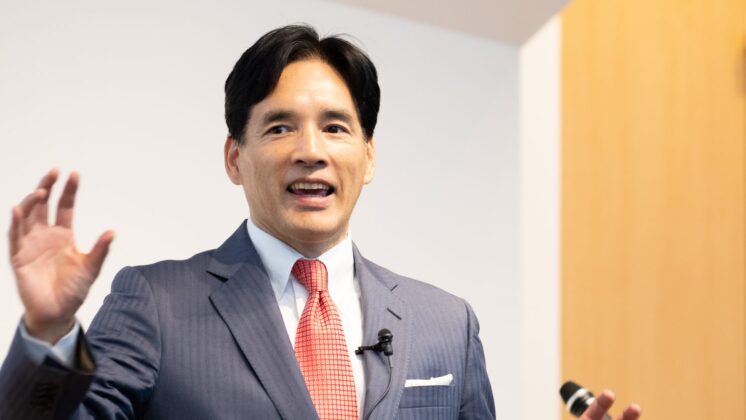(I produced this column based on my own tweets. I made minimal corrections and additions to my tweets, thinking that columns like this should communicate how I was feeling and what I was thinking at each point.)
My plan was to leave for the Tohoku region after viewing an exhibition titled “Two Hundred Selected Masterpieces from the Palace Museum, Beijing” at the Tokyo National Museum in Ueno. But I waited in vain at Ueno Station because of an unusual train delay on the Tohoku Shinkansen Line.
Breaking my journey at Sendai Station, I visited candidate sites for the Sendai Campus of the Graduate School of Management, GLOBIS University, for preliminary inspections. The Sendai Campus is drawing students at a pace much faster than we had anticipated because it will be the first school in the Tohoku region to offer an MBA program. To accommodate the positive response, we decided to set up a physical campus in Sendai earlier than we had scheduled. We would like to produce leaders from the Tohoku region. We want to offer a positive learning environment for our candidates.
Spending a little less than two hours in Sendai, I visited three candidate properties to give them a preliminary look. I then went to Sendai Station, hopped on a bullet train and headed for Morioka. Service had already returned to schedule on the Tohoku Shinkansen Line and the trains were running on time.
I disembarked at Morioka Station and joined actor Takuro Tatsumi. Meeting other KIBOW Tono Meeting participants at the station, we went and checked in at our hotel. We then boarded a bus together and traveled two hours to Tono City where the KIBOW Tono Meeting would take place.
Our bus left the west exit of Morioka Station for Tono, where the temperature was said to be 15 degrees below zero. We are introducing ourselves on the bus right now. It’s time for a Northern Iwate Transportation Inc. employee in charge to say a few words to us. The bus company is doing a great deal to help us on both the Morioka and Sanriku Coast routes on this occasion. I’d like to thank the company for its wonderful cooperation. According to the bus company employee, a retiredA footballer who played used to play for the J-League’s Kashima Antlers club is traveling with us on the same bus. Instead of the KIBOW t-shirt, he isI am wearing a t-shirt he I bought in June 2011 that says, “Iwate Never Gives Up.”
We have arrived in Tono. We disembarked and walked to the Tono Beer Garden, which is operated by Kashiwagidaira Lake Resort. In this Western-style wooden building, we warmed ourselves by huddling around an old familiar kerosene heater. After saying hello to everyone in the building, Tatsumi and I made a toast with a glass of a locally brewed beer called Kappa Beer. The KIBOW Tono Meeting is set to start in 10 minutes. But a bus from Kirikiri via the Sanriku Coast has yet to arrived.
The bus from the Sanriku Coast finally arrived. I kicked of the KIBOW Tono Meeting with my own speech. When we visit an affected site we realize how the challenges have changed over time. A clear vision and a well-defined plan for reconstruction are important now. Unfortunately, no such vision has emerged yet. Only when it does, will physical reconstruction proceed fully. Work for rebuilding stricken communities will end with the construction of a 14-meter-plus embankment along the entire coast unless administrators listen to local opinions and work out bold policies.
Excellent individuals, such as Masahiko Haga of the Kiri Kiri Koku nonprofit organization, Kazuhiko Tada of the Tono Magokoro Net, and Iwate prefectural assembly member Seiji Fukui are taking part in the KIBOW Tono Meeting. I ask them to take actions whatever the cost so that the vision for the reconstruction of this area will reflect local opinions. I believe in their potential.
Unlike the previous KIBOW gathering in Ishinomaki, the KIBOW Tono Meeting advanced proceeded in at a nice,slow and relaxed waypace. Phases have shifted from the relief of afflicted areas in the earliest period to their revival. People involved seem to be experiencing agony now as the phase has moved to difficult confrontation with bureaucrats. An impression of smoldering discontent has replaced a heated atmosphere.
Takuro Tatsumi is saying a few words now. “We need to go back to the good old Japanese value called coexistence with nature.” His words touched me. The KIBOW Tono Meeting ended with my closing speech.
We are on a bus following the KIBOW Tono Meeting. There is another bus for the Sanriku Coast parked next to ours. Our bus is bound for Morioka and left Tono first. We waved as hard as we could from our bus windows. We had met as strangers and parted as friends. The key phrase for us is, “Let’s meet at the next KIBOW Meeting.” Our shared wish is to meet again as a better person.
The 11th KIBOW Meeting in an affected area ended just nowwith success. The KIBOW Yamamotocho Meeting on March 20 will be our next event. In our second year, Wwe will be hosting the third round of KIBOW Meetings in new communities in their second yearsome of the towns we visited. We plan to continue our activities under this Project for the long term, with a persistent approach. I’m looking forward to the next KIBOW Meeting, wondering about the new encounters it will offer.
I’m on the return journey to Morioka now, about an hour and a half. I’ll stay in Morioka overnight, and then proceed to Aomori tomorrow morning to attend the G1 Summit. Next, I’ll travel further north from Aomori.
February 2012
Yoshito Hori
Written on the basis of my own tweets



